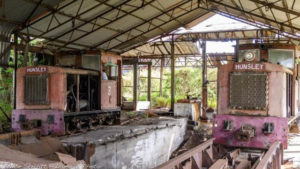 The St. Christopher National Trust welcomes the government’s announcement that the old sugar factory should be recognized as a heritage site.
The St. Christopher National Trust welcomes the government’s announcement that the old sugar factory should be recognized as a heritage site.
At the Prime Minister’s recent monthly press conference (Tuesday, October 2nd 2018) Minister of Agriculture and Lands The Hon. Eugene Hamilton, announced that the government was moving to clean up the area and would engage with the National Trust about future plans for the site.
“We engaged the Heritage Society [National Trust] because like Brimstone Hill, like Spooner’s Ginnery, it is a heritage site…The Heritage Society has given a view, and I know that they are actively working based on their communication with us, for recommendations to the government of what ought…to happen to that site,” Minister Hamilton said.
“Before we came to government there was a contract to dismantle certain aspects of the Sugar Factory site…we’ve inherited the site [that is] in a very dilapidated, in fact very dangerous condition,” he explained
The Minister said that the priority would be to have loose galvanize removed from the metal frames of the building, and he indicated that quotations for the cost of removal were before the Cabinet for consideration.
Since the closure of the sugar factory in 2005, the St. Christopher Heritage Society (now the St. Christopher National Trust) has called for the preservation of the factory and advocated for the establishment of a sugar museum on the site. In the years since then other industrial businesses have come to occupy sections within the compound. The main factory building which still contains most of the equipment and a couple of the other structures have been abandoned. Despite much of the remaining equipment being exposed to time and the elements, they are still visually dramatic and retain much of the atmosphere of the era when Sugar was King.
On Tuesday, Minister Hamilton spoke about the government’s ongoing communication with the National Trust about site.
“Influenced by the Heritage Society and hopefully by members of the community who have an interest, the government will respond in a way that will ensure that what is done there will be pleasing to the majority of persons in St. Kitts and Nevis.”
National Trust Executive Director Ryllis Percival was pleased to hear the Minister acknowledge the historic importance of the site.
“We were thrilled, and truthfully somewhat relieved, to hear that the government seems committed to preserving what remains of the factory,” she said.
Executive Director Percival, Trust President Schneidman Warner and members of the Trust’s Building and Sites Committee visited the old factory compound to assess the condition of the buildings and remaining equipment. The organization has renewed its lobbying of the government to preserve what remains of the factory works. It is proposing that they be developed into a museum with an interpretation area, visitor center and gift shop.
“We are excited that we have finally been able to convince our Government that this site is a heritage site and should be protected and preserved. The Trust has actively advocated for the Sugar Museum and we are proud that we are one step closer to making it a reality” Ms. Percival said.
“The Sugar Factory represents an era of our history that needs to be preserved for future generations; but not just for future generations, but in memory of all of those who worked in the industry. This site will not just be a museum, it will be a memorial,” she stated.
About the St. Kitts Sugar Factory
In the 1880s the sugar industry started a downward spiral caused largely by the drop in the price of sugar. It was felt that by eliminating all the small operations on the various estates and centralizing operations of the sugar industry, production would be more efficient. The central sugar factory on St. Kitts was built during 1910 and 1911 and opened in 1912. A pier and railway were also constructed as part of the operation. The factory succeeded in making sugar production a bit more profitable and also created a centralized, highly skilled labour force.
Initially there were both British and local share holders in the new enterprise. 1976, the factory, the land that it was on, the machinery and railway were bought out by the government. However, the price of sugar continued to decline and the aging factory works required a significant outlay of capital for maintenance and improvement. By the turn of the century 21st century, the sugar industry was heavily subsidized by the government and a decision was finally made to cease operations in July 2005.
